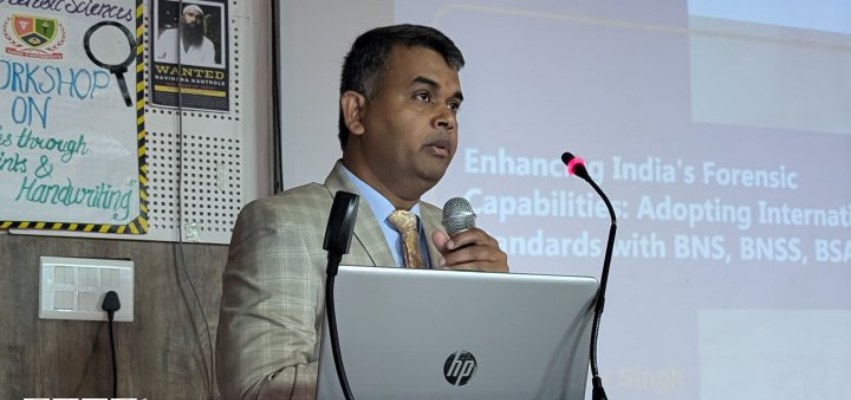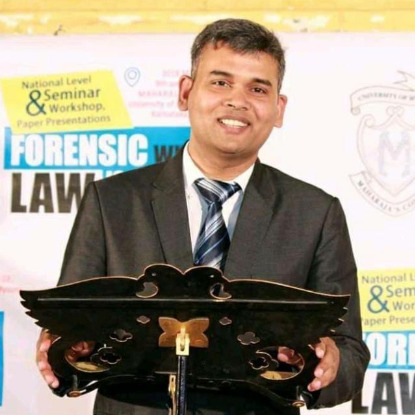On April 21 and 22, 2025, I had the immense pleasure of being part of a transformative workshop titled "The Truth Through Prints and Handwriting", organized by the NIMS School of Forensic Sciences, Rajasthan, Jaipur.
Over the course of two enriching days, I witnessed not just a classroom of curious learners, but a gathering of future forensic professionals deeply engaged in unraveling the silent truths hidden in fingerprints and handwriting.
As a forensic expert, I’ve always believed that education becomes powerful when it’s hands-on.
This workshop was exactly that—a practical and immersive experience, thoughtfully designed to bridge the gap between theoretical learning and field application.
Setting the Stage: Day One
From the moment I arrived on April 21, the enthusiasm was palpable. The day began promptly at 9:00 AM. Alongside my esteemed colleague Dr. Vijay Rustagi and the incredibly driven team from the Sherlock Institute of Forensic Science (SIFS), New Delhi, we were welcomed warmly by the faculty and students of NIMS.
The workshop kicked off with an introduction to the fundamentals of fingerprint analysis. We began with the basics—ridge patterns, minutiae points, classification systems—but quickly moved into more advanced discussions.
I conducted a live demonstration on lifting latent prints using various powder and chemical techniques.
The students didn't just observe—they practiced. Watching them lift, analyze, and classify prints with increasing confidence reminded me why workshops like these are so crucial.
Later in the day, we transitioned into the realm of handwriting analysis. Dr. Vijay Rustagi led this session with his signature energy and expertise. His session focused on forgery detection, signature comparison, and pressure pattern examination.
I complemented his segment with practical exercises, encouraging students to compare writing samples under magnification and identify distinguishing features.
What stood out to me was how quickly they grasped complex concepts when given the chance to engage directly with real materials.
A Hands-On Learning Environment
Both days ran from 9:00 AM to 4:00 PM, but the time flew by. We packed in practicals, Q&A sessions, and interactive group tasks.
I was especially impressed by how the students embraced challenges—like identifying forged signatures or comparing distorted latent prints—without hesitation.
One group even correctly pointed out a simulated forgery I had prepared as part of a surprise test, demonstrating their attention to detail.
Their dedication reminded me that with the right environment and mentorship, India’s forensic future is in capable hands.
Day Two: A Milestone Moment
April 22 wasn't just another day of learning—it was a day of legacy. After another powerful session on fingerprint distortion and disguised handwriting, we all gathered in the main hall for a very special event.
Between 2:00 PM and 4:00 PM, a historic partnership was formalized: NIMS University, Jaipur, signed a Memorandum of Understanding (MoU) with the Sherlock Institute of Forensic Science, New Delhi. As someone deeply invested in both academia and field practice, this moment filled me with pride.
The MoU represents more than just a formal agreement—it’s a commitment to collaborative growth in forensic science education, research, and real-world application.
With this partnership, students of NIMS will now have direct access to the SIFS network, resources, and field projects. It will open doors for internships, collaborative research, and advanced forensic training.
Being physically present during the signing, alongside Dr. Rustagi and our dedicated SIFS team, was a powerful reminder that our mission is bigger than any single workshop.
We are laying the foundation for a future where education and application move hand in hand.
The Students: A Source of Hope and Motivation
Throughout the two days, the students impressed me with their questions, their willingness to experiment, and their deep interest in the science behind every fingerprint ridge and ink stroke.
Their energy reaffirmed something I’ve always believed: India doesn’t lack talent—it needs platforms. And this workshop was one such platform.
Some students approached me after the sessions, asking about career paths in forensic science, scope for international collaborations, and the best certifications to pursue.
These weren’t just passing questions—they were purpose-driven. I made it a point to guide them individually and provide real-world context based on my own professional journey.
Looking Ahead: Strengthening the Forensic Ecosystem
Workshops like these are not mere events—they’re seeds. Seeds that, when nurtured, grow into skilled professionals capable of delivering justice, solving crimes, and upholding truth in a digital and physical world.
With the MoU now in place between NIMS and SIFS, I see great promise. We plan to initiate certification programs, field exposure visits, and research collaborations.
My hope is to see more institutions across India follow this model—where expertise from the field meets academic zeal in the classroom.
A Note of Gratitude
I am grateful to the entire faculty and organizing team at NIMS School of Forensic Sciences for their dedication, warmth, and flawless coordination. A special thank you to the students—your curiosity and commitment made every minute worthwhile.
To Dr. Vijay Rustagi and my SIFS team—you bring energy, precision, and a spirit of excellence that lifts every session we conduct together. Our shared mission continues.
Final Thoughts
As I left the campus that evening, I reflected on the words of one student who said, “Sir, I always thought forensics was just theory. Now I know it’s an art, a science, and a responsibility.”
That one line made it all worth it.


